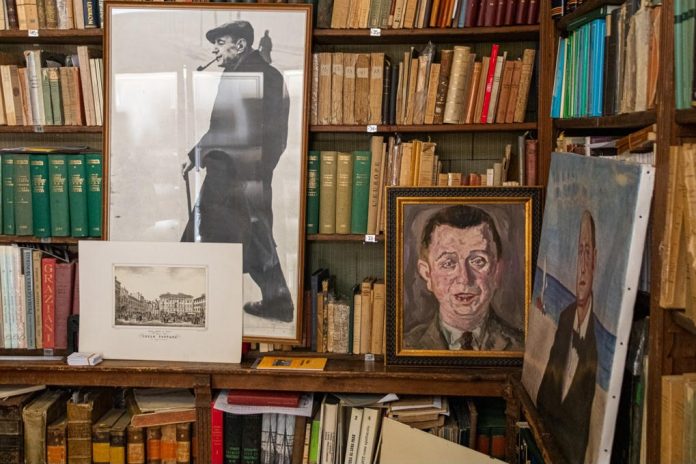by Victor Caneva
Libreria Antiquaria Umberto Saba is a Trieste institution. Walking in its doors warmly transports the visitor back in time, with rare books and antique volumes rising from floor to ceiling in haphazard perfection. Works pleasantly and indiscriminately overflow on tables also housing objects used by Trieste’s most famous melancholic poet, Umberto Saba.

Saba himself acquired the bookshop just over a hundred years ago. The libreria soon became a local haunt for Trieste’s most illustrious intellectuals such as Italo Svevo, Giani Stuparich, Scipio Slataper, and Virgilio Giotti.
In 1924, Saba hired the young Carlo “Carletto” Cerne as a bookseller who would be instrumental in the shop’s commercial success. Carlo’s business acumen surpassed that of Saba’s, who was snarky with clients, sometimes even throwing them out of the shop!
After Saba’s passing in 1957, Carlo ran the bookstore until his death in 1981. Since then Carlo’s son, Mario Cerne, has run the shop, navigating the historic establishment through the less than soulful onslaught of the information age.
Numerous articles have been written about the history of the libreria and Mario Cerne has been asked the same questions about his connections to Umberto Saba many times. So, when I spoke with Mario, I simply chatted with him about Trieste and let the conversation go from there.
I love hearing what Triestini think and feel about their city, so I asked Mario what made Trieste special. Mario observed that Trieste is very unique, not necessarily because it is the prettiest of cities, but because of an incomparable history. Trieste has changed hands more times since 1918 than anywhere else in Europe and this has shaped the city’s essence.

With an evident sadness, Mario lamented that as the world has become smaller and business models have changed, Trieste has lost some of its particularity. Neighborhoods like San Giacomo and Servola once exhibited a Triestine-ness that made them truly unique rioni, but the introduction of chains and simple modernity have slowly eroded their identity.
Mario advised that if I wanted to have a singularly Triestine experience, I should visit Bagno Pedocin, a beach located next to the Lanterna, Trieste’s old lighthouse. Preserving tradition from Austrian times, the beach is divided into sections for men and women separated by a concrete wall. Not only is it a historical experience, it only costs a euro to get in!
We moved on to the antique book business. Mario expressed that interest in these special works is decreasing. Young people are becoming accustomed to having immediate access to information via smartphones and don’t see the value in hard-to-find volumes. I remarked that I found this sad, but Mario disagreed, saying, “it isn’t sad or happy, it is simply the evolution of time. Ways of living have always shifted and we are currently in the midst of immense change.”
Despite his enlightened response, I personally hope Libreria Antiquaria Umberto Saba prevails for a long time, preserving a precious piece of Trieste’s literary legacy.





























